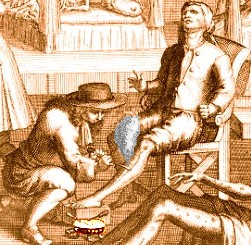
Cauterizing Procedure Page Menu: 1 2 3 4 5 6 7 8 Next>>
Cauterizing Procedure During the Golden Age of Piracy, Page 2
Cauterizing in the Golden Age of Piracy, Pro and Con
In his books published at the end of the 16th century, Ambroise Pare introduced doubt about the need for cauterizing. The debate over whether to use them or not continued for several hundred years, including the golden age of piracy during the late 17th and early 18th centuries. Let's look at some of the reasons for and against the cautery procedure mentioned by our period and near period surgical authors.
It is worth noting that some of these pros and cons are based on the comments from a single author. As a result, it cannot be said that such things were a common practice at this time. However, in the interest of thoroughness, I have included all of the reasons I came across in period and near-period surgical literature here.
Pro: Preventing Corrupt Humors
German surgeon Matthias Gottfried Purmann advised that cauterizing a site could burn up the 'corrupted' humors that were thought to gather at wound sites. As he explains in his discussion on surgical instruments, when dealing with a stubborn and malignant distemper, "Actual Cauteries, burning with a hot Iron or Corrosives, must take place, among which burning with Moxa [a chemical cautery made from dried mugwort] must be reckoned as one of the best Applications

Artist: Duomo Milano
Treating a Gangrenous Leg, From
Miracle of the Gangrenous Leg
in this kind, because it not only makes but one Spot or Blister, but draws away what is malignant, superfluous, and keeps the Part from healing, but consumes the latent peccant [offending] Humour with greater Ease and Benefit to the Patient, than any other Actual or Potential Cautery."1
1 Matthias Gottfried Purmann, Churgia Curiosa, p. 2
Pro: Removing Gangrene
While Ambroise Paré was in favor of replacing cauterization where possible, he also recognized that it was useful for certain operations. One of these was to destroy "Gangreene or putrifaction", further commenting that the application of cautery irons to a vessel was "cheefly to correct the malignitie, or gangrenous putrifaction which might spoile the neighboring parts."1
He does note that it is not necessary to use them in a gangrenous limb which has been amputated "to consume, and drie the putrifaction, which is a common thing in Gangreenes, and mortifications ...because the practice is to amputate the part above that which is mortified, and corrupted; as Celsus writes and commands, to make the amputation upon the sound part, rather than to leave any whit of the corrupted."2 So if the surgeon had performed the procedure as Paré explained, all the gangrenous flesh would have been removed, making cauterization unnecessary.
1 Ambroise Paré, The Apologie and Treatise of Ambroise Paré, p. 8; 2 Paré, p. 8-9
Pro: Stopping Bleeding

Stopping Bleeding From Discours De la Phlebotomie,
by David de Planis Campy, frontispiece (1621)
This is one of the most widely supported use of cautery irons among the surgical writers under study. German surgeon Matthias Purrman says that cauterizing irons and cauterizing medicines were "seldom applied, unless it be to stop the Violent Bleedings of the Veins or Arteries"1. James Yonge, who, while he was personally in favor of more enlightened methods to stop bleeding, does recognize that many surgeons in the late 17th century agreed "that nothing can more effectually secure the bleeding of wounds, than Cauteries."2 While amputating a ship's boy's thigh, naval physician Hugh Ryder explained that he was 'was forced to make use of cauterizing irons, "by reason of the largeness of the Vessels, from whence otherwise I might have expected in a few minutes his whole Mass of Blood, and Life to have been exhausted."3
1 Matthias Gottfried Purmann, Churgia Curiosa, p. 306; 2 James Yonge, Currus Triumpalis, é Terebinthô., p. 3; 3 Hugh Ryder, New Practical Observations in Surgery Containing Divers Remarkable Cases and Cures, p. 57
Con: Attracting Corrupt Humors
Although German surgeon Matthias Purmann believed cauterization would burn up corrupt humors, sea-surgeon James Yonge said they would encourage them. While talking about treating a sword wound in the thigh, Yonge reasoned, that "if in this very case I had used a Cautery, or Corrosive [potential cautery], to which (they being the Ultimum Refugium [the last refuge]) I might have been tempted, on such an extremity, I had not in all likelihood provoked worse symptoms from their much greater heat, which would have kindled the humour into a stronger flame, and perhaps (though he had been so much bleeded [bleeding was thought to purge corrupt humors]) have begotten a Frenzy."1
1 James Yonge, Currus Triumpalis, é Terebinthô., p. 83-4
Con: Creating Patient and Surgeon Discomfort
"Let us come now to Reason,
Now so it is, that one cannot apply hot irons but with extreame and vehement paine in a sensible part, void of a Gangreene". (Ambroise Paré, The Apologie and Treatise of Ambroise Paré, p. 7)
Although

The Pain of Cautery, From The Martyrdom of
Mercury, by J. Sintelaer, p. 104-5 (1709)
some believe surgeons from this time in history must have been mad sadists, most of the surgeons writing about surgical practices at this time expressed extraordinary concern for the pain the patient had to endure during various operations. As John Kirkup notes, "cautery was a horrendous trial both for patients and surgeons"1.
Sea surgeon John Woodall says with regard to cautery irons that "the use of them in many cures is now forborne by reason the terror thereof to the Patient is great, yet the use of them is very needful"2. Naval surgeon John Atkins suggests that delegating an artery (that is, bandaging, or tying it with a ligature as Ambroise Paré suggests in his book) should have "Pre-eminence in Practise, [because it is not] carrying the Dread a Cautery does"3.
When talking about the use of cauteries to burn wounds closed, Paré himself is most forceful in his opinion against cauterizing. He explains that this treatment "could not but bring great and tormenting paine to the patient, seeing such fresh wounds made in the quicke and sound flesh are endewed with exquisite sense. Neither can any causticke [potential cautery] be applied to nervous bodies, but that this horrid impression of the fire will be presently communicated to the inward parts, whence horrid symptomes ensue, and oft times death it selfe."4

Author John Woodall
Woodall even admits that he can see the need to use them in certain operations, "yet I confesse I make no use of them my selfe in that kinde, because of the feare they put the Patient unto, and for speech of people, who are ready to scandalize an Artist upon each light occasion."5 (Woodall's last comment refers to the bad word-of-mouth that could result when the surgeon failed to cure a patient.)
Sea surgeon James Yonge excoriated the popular idea that cauterizing was the best way to complete an amputation. He says that the surgeon's "cruelty [when cauterizing] is beyond all Apology: when a member [limb] after it hath been lacerated, and torn asunder by a Canon shot, and undergone a new extirpation by the Chyrurgeons Knife and Saw, must be cruciated [burned at the end in the form of a cross] by the dreadful, often needless, frequently mischievous application of his hot Irons"6.
Historian John Keevil notes that "it is indeed hard to find any evidence of that 'searing'... being used in ships."7 Keevil theorized that "the close relations between the ship’s surgeon and his patients went far to produce a revulsion from an inhuman method."8 If Keevil is correct, as his research seems to suggest he is, it puts paid to the idea that the ship's surgeon was secretly a sadistic torturer. As the eminent Paré says, "that which may bee done gently without fire, is much more commended than otherwise."9
1 John Kirkup, The Evolution of Surgical Instruments; An Illustrated History from Ancient Time to the Twentieth Century, p. 218; 2 John Woodall, the surgions mate, p. 10; 3 John Atkins, The Navy Surgeon, p. 122; 4 Ambroise Paré, The Apologie and Treatise of Ambroise Paré, p. 156; 5 John Woodall, ibid., 6 James Yonge, Currus Triumpalis, é Terebinthô., p. 13-4; 7,8 John J. Keevil, Medicine and the Navy 1200-1900: Volume II – 1640-1714, p. 159; 9 Paré, p. 7

